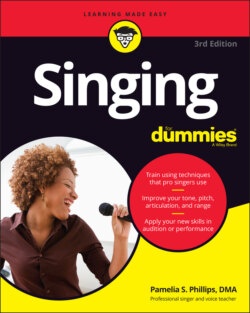Читать книгу Singing For Dummies - Pamelia S. Phillips - Страница 22
Sifting through the Ingredients to Figure Out Your Voice Type
ОглавлениеThink of a voice type as a series of ingredients mixed together to create a unique-tasting dessert. For singing, the ingredients combine to create a unique-sounding voice. The four common voice types are soprano, mezzo-soprano (often called mezzo), tenor, and bass (the next section, “Identifying the Fab Four,” tells you all about these four voice types). These five ingredients determine a voice type:
Age: Many singers are assigned a voice type as young singers, but voices change with age. The muscles in the larynx continue growing and developing into the early 20s. Think about the last time you made a phone call and heard the sound of a stranger’s voice. Even if you didn’t know the person on the other end, you could guess their age by listening to their speaking voice. Because speaking voices and singing voices change with age, wait until your body is finished growing to determine your voice type.
Range: Range is all the notes a singer can hit — including the highest note, the lowest note, and all the notes between. Beginning singers usually have a shorter range than more advanced singers, because the high notes or low notes get stronger with practice. As you practice the exercises with this book and accompanying online tracks, your range can expand whether you’re a beginner or an advanced singer. Knowing your range helps you figure out your voice type, because a bass can sing lower than a tenor, and a soprano can sing higher than a contralto. The factors that most affect how you determine your voice type are range, in which part of your range you’re most comfortable singing, and register transitions.
Register: Register refers to a series of adjacent notes that sound similar, are produced in a similar fashion, and have a similar tonal quality. The notes sound similar because the same muscles produce them and they often vibrate in a similar location in a singer’s body. The transitions between the registers can help you determine your voice type. Keep reading this chapter to find out where each voice type feels transitions to help you decide whether your voice does something similar. The transitions in your voice may change as your voice develops. (Chapter 11 has more on registers.) The range of the voice where a singer is most comfortable is called tessitura. If you hear the word tessitura used in a discussion about a song, in that case, it refers to the area where most of the notes lie in the song. The tessitura of a Stevie Wonder song is quite high, because he’s comfortable singing a lot of high notes. The tessitura for “God Bless America” and most folk songs is lower. Knowing where your voice is most comfortable, as well as where it’s uncomfortable, is a determining factor when it comes to voice type.
Tone of voice: Each voice has a specific tonal quality or timbre. Words that describe tone include strident, dark, bright, metallic, ringing, and shrill. When determining a voice type, the voice tone helps you further determine your category. The tone of voice for a tenor is often much brighter than the tone of voice for a bass.
Voice strength: Knowing your voice strength also helps you determine your voice type. Sopranos and tenors have a stronger head voice than mezzos and basses. Likewise, mezzos and basses have a stronger, meatier middle voice than sopranos and tenors. (Chapter 11 gives you details on head voice and middle voice.)
Don’t classify yourself too quickly based on the preceding factors. For the general purposes of singing, focus on building great technique and see how your voice responds. Your voice tells you what voice type it really is; you just have to know how to look and listen.
